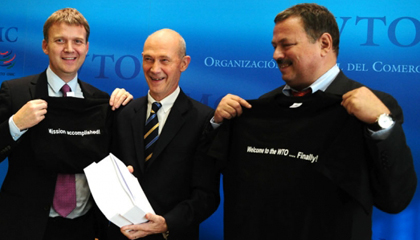California Agricultural Technology Institute
Export opportunities with Russia arise
Recent analyses conducted by economists with Fresno State’s Center for Agricultural Business (CAB) have indicated that America’s once-feared cold war enemy – Russia – is warming up to new agricultural trade partnerships with U.S. exporters.
 In a June report to members of the California Specialty Crops Council in San Francisco,
CAB Director Dr. Mechel Paggi (left) said Russia is now considered an “emerging market”
for U.S. farm products, including several specialty crops produced mainly in California.
In a June report to members of the California Specialty Crops Council in San Francisco,
CAB Director Dr. Mechel Paggi (left) said Russia is now considered an “emerging market”
for U.S. farm products, including several specialty crops produced mainly in California.
“U.S. exports of raisins and mixed dried fruit reached new records in fiscal year 2011, with the value of raisin exports to Russia increasing 25 percent to nearly $1.8 million and the value of mixed dried fruit exports more than tripling to nearly $1.2 million,” Paggi reported to the council. Import demand for prunes has doubled in the last five years, making Russia now the largest importer of prunes in the world. The United States supplies about 20 percent of that market, with record sales of $12 million in 2012, Paggi noted.
Other California crops seeing trade growth to Russia are fresh fruits such as apples, pears and grapes. In the last decade, for example, the value of U.S. grape imports to Russia grew from less than $1 million to $8 million; pear imports have risen from less than $1 million to nearly $12 million; and apple sales have surged from about $1 million to nearly $16 million.
Fresh berries also are seeing more demand from Russian consumers, especially strawberries, raspberries and blueberries. Although the U.S. share of the Russian berry market is still small at about 1 percent, overall demand in that country is rapidly rising, growing from just over $20 million in sales in 2006 to more than $100 million in 2011.

World Trade Organization leader Pascal Lamu (center) and leader of the Russian negotiation
team Maksim Medvedkov (right) celebrate the inclusion of Russia in the trade club.
Photo: wto.int
California tree nut sales to Russia have grown exponentially in recent years, Paggi reported, as Russia is “entirely dependent on imports for tree nuts other than pine nuts, and consumer demand continues to increase.”
Trade studies show the value of tree nut imports into Russia jumped from less than $50 million in 2004 to nearly $400 million in 2011. The United States currently owns 29 percent of the total market share for Russian tree nut imports, including 90 percent share of the almond market. This rise in purchasing of both almonds and pistachios in Russia has been a welcome trend for California producers.
Two key factors have fueled the trade impetus with Russia, Paggi stated. First, that country’s economy is growing at a good pace in recent years, with 4.0, 4.3 and 3.4 percent expansion reported for 2010, 2011 and 2012, respectively. Secondly, Russia recently joined the World Trade Organization (WTO), meaning the government will commit to lowering tariffs on certain products such as citrus fruits, table grapes and raisins, pears and prunes.
Logistics – the simple movement of goods around Russia – continues to be a major limiting factor affecting trade, Paggi noted. Interior Russia does not have major waterways connected to the sea, such as the Great Lakes region or Mississippi River in the United States. The main sea ports of entry to Russia are St. Petersberg in the west and Vladivostok on the east, bordering China on the Sea of Japan. From either of those two ports, most goods must be shipped sometimes thousands of miles by train or truck to reach inland centers such as Moscow.
Business trends in Russia show the retail sector growing, including the demand for food products...
“The ongoing development of the mass grocery retail industry will allow producers to route products to the market more efficiently,” Paggi said. However, the purchasing power of consumers remains relatively low, and strong competition exists for many products imported from the European Union and other countries, he noted.
With a population of 143 million, Russia is considered among the world’s top five future growth engines and markets for global trade (along with Brazil, India, China and South Africa).
“Russia’s retail sector is growing, which creates a number of opportunities for prospective U.S. exporters, and significant numbers of consumers can afford purchasing high-quality food products,” Paggi said. So in spite of infrastructure weaknesses and other challenges, the market is something California and U.S. producers should considering exploring.
A complete pdf version of Paggi’s report is available on the CAB website at www.csufcab.com.
For more information on CAB activities and research, contact Paggi at mpaggi@csufresno.edu or call the CAB office at 559-278-4405.